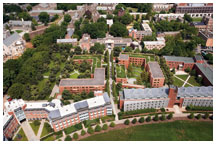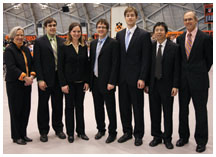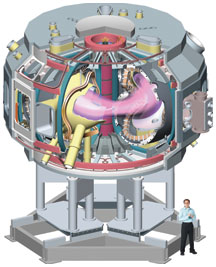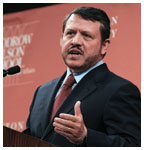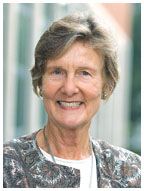
|
March 19, 2008: Notebook
Thinking green: Princeton sets sustainability goals
Celebrating ‘all things
Princetonian’
On Alumni Day, top awards go to Rogers ’80 and Goldman *69 *76
Students receive University's highest honors
Speaking out on risky drinking
Critical review prompts stepped-up scrutiny of PPPL
Jordanian king sees urgency for peace efforts
A ‘bridge year’ of service abroad
Public service after ‘stepping out’
Green roofs, with vegetation planted over a waterproof covering, are shown in this rendering of the Butler College dorms, to be completed in fall 2009. (Artwork by Peter Roper) |
Thinking green: Princeton sets sustainability goals
Princeton vowed to reduce its carbon dioxide emissions to 1990 levels by 2020, mirroring a goal set by the state of New Jersey last summer, as part of a sustainability plan released Feb. 21. The University’s plan also lists goals for resource conservation, research, education, and civic engagement.
Reaching the 2020 goal will require the University to cut carbon dioxide emissions by more than one-third (from about 150,000 metric tons in 2007 to 95,000 metric tons, the 1990 level), which poses a significant challenge for a campus that, according to the plan, already employs one of the nation’s most efficient central power facilities. And the campus is growing: Between buildings already added and construction planned in the coming decade, Princeton will have about 3.5 million more square feet to heat, cool, and illuminate in 2020 than it did in 1990.
Shana Weber, the University’s sustainability manager, said that reaching the 2020 goal is “going to require participation from everyone on campus ... from conservation in dorm rooms to installing geothermal [heating and cooling] systems on campus, from the visible to the invisible solutions.”
Executive Vice President Mark Burstein said that the plan will require “tens of millions of dollars” to support capital improvements, such as the construction of more energy-efficient buildings, and operational investments. The University also plans to use $325 million from its ongoing capital campaign for research and teaching in the areas of climate change and alternative energy.
In drafting the plan, the committee spelled out goals for “real and measurable progress.” Among the specific goals:
• Convert all cleaning products to Green Seal environmentally responsible products (or equivalent) by 2009.
• Increase the recycling rate for waste from dormitories and other campus buildings to 50 percent by 2012 (from 38 percent in 2007).
• Decrease the number of cars commuting to campus by 10 percent and cut per-student personal water use by 25 percent by 2020.
Stronger sustainable-building guidelines could help the University trim energy use. Under Princeton’s initial guidelines, released in 2006, new buildings and renovation projects were designed to be at least 30 percent more energy-efficient than building-code requirements. The sustainability plan calls for projects to be 50 percent more energy-efficient than the code requires, and all new buildings will be designed to meet the Leadership in Energy and Environmental Design (LEED) silver standards, set by the U.S. Green Building Council.
The 2020 carbon-emissions goal is the most significant target in the report, and it reflects the idea that commitment to environmental sustainability “begins at home,” according to Burstein. Several universities have pledged to become “carbon-neutral” by purchasing offsets, which fund off-site projects that reduce greenhouse gas emissions, but Princeton eschewed that option. “The solution to this problem can’t come from everyone buying offsets,” Burstein said. “Someone must decrease their own emissions.”
Improved storm-water management, upgrades for campus shuttles, and a greener approach to purchasing supplies could contribute to reducing Princeton’s environmental footprint, according to the plan.
The plan was drafted by a committee of administrators, faculty, staff,
and students, drawing on research from affiliated working groups and feedback
from University trustees. Student-related projects, such as new courses
and internships, will be funded by the High Meadows Foundation, co-founded
by Princeton trustee Carl Ferenbach ’64 and his wife, Judy. The
full sustainability plan is available online at http://www.princeton.edu/pr/reports/sustain/.
![]()
By B.T.

(Photos by Sameer A. Khan, courtesy the Alumni Council) |
Celebrating
‘all things Princetonian’
On Alumni Day, top awards go to Rogers ’80 and Goldman *69
*76
For John Rogers ’80, there couldn’t have been a better location to be recognized as this year’s Woodrow Wilson Award winner than Jadwin Gym.
“This was the first part of campus I saw when I first visited Princeton, and I fell in love instantly,” Rogers told the audience of more than 1,200 who attended the annual Alumni Day luncheon in Jadwin Feb. 23. “The opportunity to play basketball at Princeton completely changed my life.”
Rogers is the first African-American to receive the award, the highest honor given by the University to an undergraduate alumnus. He was recognized for his work as head of Ariel Capital Management, the nation’s largest minority-run mutual fund firm, and for his civic involvement in Chicago.
Although told by one of his coaches that he was “legally blind when it came to passing” the ball during his freshman year, Rogers went on to become team captain. Rogers said he never met anyone who understood the value of teamwork as former coach Pete Carril did and, addressing Carril in the audience, added: “Coach, you were absolutely the best teacher I ever had.”
Lawrence P. Goldman *69 *76, the chairman and chief executive officer of the New Jersey Performing Arts Center in Newark, was honored as the James Madison Medalist, the University’s highest award for a graduate alumnus. Describing himself as a child of the ’60s, Goldman said his life’s work “started right here at the University.”
Goldman began his graduate studies 15 days after riots shook Newark, and New Jersey’s largest city became a focus of Goldman’s urban studies at the Woodrow Wilson School. He would return to Newark in 1989 as president of the proposed New Jersey Performing Arts Center, and the success of the center — which opened in 1997 — has been widely regarded as a critical factor in a turnaround for the city. Stephen Oxman ’67, head of the executive committee of the University trustees, said Goldman “has made an institution with heart and soul that is rooted in the community.”
In addition to the presentation of the two top alumni awards, Alumni Day featured the winners of Princeton’s highest student awards as well as faculty lectures on topics that included Islamism, global warming, a psychologist’s view of universal biases in the brain, and a progress report on the University’s new Lewis Center for the Arts.
After the luncheon, many alumni, family, and friends attended the Service of Remembrance, held annually in the University Chapel, to honor alumni, students, faculty, and staff who died in the past year.
During a discussion of campus life, Dean of the College Nancy Malkiel was questioned by parents of students about the University’s three-and-a-half-year-old policy designed to stem grade inflation. While Malkiel conceded that not all students are happy with the policy, she said there is “no evidence that any negative impact or damage to the fortunes of Princeton students is being seen.”
Malkiel also praised the quality of this year’s admission applicants following the end of the University’s early-admission program, and said this is the first year in Princeton’s history in which men and women have applied in equal numbers.
The day started with an address in Richardson Auditorium by Goldman on how the performing arts contribute to child development and “to the restoration of our common humanity — our sense of community, our civil society.”
Goldman told how his work overseeing a major renovation and expansion of Carnegie Hall in the 1980s had demonstrated the intersection of urban redevelopment, social change, and the performing arts. His return to New Jersey in 1989 “was the break of a lifetime,” he said. “All the public-policy issues about which I was most passionate were encompassed in this incredible pioneering opportunity to build a world-class performing arts center in a tired, deteriorated, much-maligned city. I thought I had died and gone to Woodrow Wilson School heaven.”
Rogers’ address focused on how well Americans are planning for their retirement. All too often they do not invest their savings wisely and don’t know what to do with their money when they withdraw it, he said, citing statistics showing that the problem is especially acute in the case of minority workers. With many retirement plans self-directed, he said, it’s like “handing over the keys to the car without driver’s ed.”
Rogers described how Ariel Community Academy, a public charter school in Chicago backed by Rogers’ firm, has incorporated financial literacy into its curriculum, and suggested the program could become a national model. “We try to instill the importance of staying the course, be patient, do your homework, and that you can’t get rich quick,” he said.
President Tilghman described the day as one that celebrates “all things Princetonian, the excellence at the heart of the University, and ... the friendship and community that, at the end of the day, makes this such a strong and vibrant community.”
David C. Siegfried ’64, president of the Alumni Association, said
that while alumni involvement at Princeton is the envy of the University’s
peers, “many are not so closely connected to Princeton. Our challenge
is to change that.” ![]()
By W.R.O.
MORE ON ALUMNI DAY, click here: A sampler of quotes from lectures and panels.

Recognized at the Alumni Day luncheon were the Class of 1982,
which received the Class of 1926 Trophy for raising $7.8 million during
its 25th reunion campaign, the largest amount ever raised by any Princeton
class; the Annual Giving Committee of New Orleans, which
received the Jerry Horton Award for expanding dollar and participation
totals; and Dennis J. Keller ’63 of Oak Brook,
Ill., who received the Harold H. Helm Award for sustained service to Annual
Giving. The Princeton Club of Wichita, the Princeton
Alumni Association of Northern New York, and the British Columbia
chapter of the Princeton Alumni Association of Canada received the S.
Barksdale Penick Jr. ’25 Award for their Schools Committee efforts.
![]()

President Tilghman and graduate school dean William Russel, far right, with students honored on Alumni Day: From left are Pyne Prize winners Landis Stankievech ’08 and Sarah Vander Ploeg ’08 and Jacobus Fellowship recipients Kellam Conover, Vasily Pestun, and Ning Wu. Jacobus winner Thomas Clark was unable to attend the event. (John Jameson ’04, Office of Communications) |
Students receive University's highest honors
The Moses Taylor Pyne Honor Prize (the highest general distinction awarded to an undergraduate)
Landis Stankievech ’08, mechanical and aerospace engineering
Stankievech, from Trochu, Alberta, Canada, is one of Prince-ton’s
three Rhodes scholars this year. A forward for the Ivy champion men’s
hockey team, he was praised by President Tilghman as “an example
of academic and athletic excellence that Princeton will long remember.”
Stankievech, who has been involved in several youth programs, plans to
earn a second bachelor’s degree at Oxford in a joint program in
philosophy, politics, and economics.
Sarah Vander Ploeg ’08, Woodrow Wilson School
Vander Ploeg, from North Haledon, N.J., is the winner of a Marshall Scholarship
and will pursue a master’s degree in vocal studies at the Royal
College of Music in London. An accomplished lyric soprano, she hopes to
become a professional opera singer. Her thesis studies the role of music
and intellectual-property law in post-apartheid South Africa, where she
believes that music can contribute to national reconciliation.
The Porter Ogden Jacobus Fellowship (supporting the final year of graduate study, it recognizes work of the highest scholarly excellence)
Thomas Clark, politics
Clark’s research examines the power struggle between Congress and
the Supreme Court and how the Constitution balances notions of power and
democracy.
Kellam Conover, classics
Studying the neglected field of bribery in classical Athens, Conover found
that the Greeks did not have a specific word for bribe. Acceptance of
a bribe was seen not as an act of greed but as a violation of the “friendship”
between a citizen and his community.
Vasily Pestun, physics
Pestun’s research is focused on string theory, exploring the relationship
between gauge theory and gravity and ultimately the fundamental workings
of the universe.
Ning Wu, chemical engineering
Praised for his exceptional command of theory and experimentation, Wu
studies the science and engineering of soft materials, specifically a
form of patterning of thin polymer films. ![]()

Speaking out on risky drinking
Campus workshops that will contribute to a plan to curtail dangerous drinking have attracted upwards of 100 participants, with students, faculty, and alumni discussing how alcohol is used on campus and what ought to change.
The Alcohol Coalition Committee invited members of the University community to “be part of the conversation” following recent revisions to campus alcohol policy. The changes included public-safety patrols in dorm hallways and, starting next fall, a larger role for residential-college advisers in enforcing alcohol regulations.
“This is not a moral crusade or some kind of temperance movement,” astrophysics lecturer Michael Lemonick said as he introduced the first workshop. “It is an attempt to look at something that is clearly a problem ... and try to make it less of one.”
The first of three workshops last month focused on reasons for high-risk drinking. In a session called “Making Memories: Alcohol as Social Glue,” athletes, fraternity members, a student government officer, a faculty member, and an alumnus drew on their personal experiences. “A lot of times ... guys will get absolutely hammered, and start to feel bad at some point, but all go through it together,” said an athlete who said he does not drink, but that his teammates often do. “You feel closer afterward.”
One student noted how alcohol lowers inhibitions. “It allows people to let their guard down in terms of conversation,” he said.
“The [social] environment makes it difficult to sit down and ask questions and talk to people,” another student said. “In other settings, like Frist lunch, it’s different, but the Street doesn’t make it easy to socialize normally.”
Several students noted the divide between those who frequent Prospect Avenue and those who stay away, and many agreed that this can be alienating on both sides. “There should be a middle ground,” one student said. “A lot of people, especially in sub-free [substance-free housing], have this ‘we don’t want to go out to the eating clubs because everyone drinks there’ mentality.”
Other colleges offer more social options, another said. “We’re in this unique situation where all you have are the eating clubs, which are not part of school, and the kind of seemingly hokey events put on by the school where there’s absolutely no alcohol allowed.”
Among the suggestions was one that not all Alcohol Initiative events be strictly dry, allowing students over 21 to drink safely and legally. The Daily Princetonian proposed that students register room parties, that fraternities and sororities be registered so that they could be held more accountable, and that it be made clear that students who bring a sick student for medical attention will not face penalties.
The committee intends to draft a plan by May, drawing on the workshops
and meetings with campus and community partners. ![]()
By Claire Abramowitz ’10

“Often, we don’t recognize that the status quo is a problem, and [we] have more difficulty covering that than we do in covering change.”
Veteran journalist Gene Roberts, explaining why the press was at first
reluctant to explore race relations in the 1950s and ’60s. Roberts
and co-author Hank Klibanoff spoke about their Pulitzer Prize-winning
book, The Race Beat: The Press, the Civil Rights Struggle, and the Awakening
of a Nation, at Robertson Hall Feb. 21. ![]()

Construction of the National Compact Stellerator Experiment, shown in this rendering, is over budget and behind schedule. (Courtesy Princeton Plasma Physics Laboratory) |
Critical review prompts stepped-up scrutiny of PPPL
The University is stepping up its oversight of the Princeton Plasma Physics Laboratory after the federal Department of Energy found shortcomings in several areas of the lab’s performance in the past year.
A key issue in the DOE’s annual report card for the lab was the management of the National Compact Stellarator Experiment (NCSX), designed to test a possible configuration for a fusion-power reactor. About 60 percent complete, the project is $50 million over budget and 34 months behind schedule, according to DOE budget documents. The department has been reviewing whether to continue to fund NCSX or to cancel it, with a decision expected in June.
The report card praised a number of areas of the lab’s performance, including a separate fusion-energy experimental facility, management of finances, and maintenance of facilities. But the University received grades of C+ in the areas of project/program management and contractor leadership/stewardship, and a grade of C for environment, safety, and health.
Of the Department of Energy’s 10 national laboratories, Princeton ranked ninth. The grading also meant that the University did not qualify for a performance-based $100,000 award.
“We’re taking DOE’s concerns very seriously, and we are working very hard at the University and the lab to address them,” said Provost Christopher Eisgruber ’83.
The Department of Energy said the lab should have recognized the schedule and cost problems for NCSX much earlier in the process, but for years it continued to report that the project was on course.
According to research dean A.J. Stewart Smith *66, the University official directly responsible for the lab, problems at NCSX were caused primarily by “the complex and precise assembly process required for this device, which is a first-of-its-kind research facility.”
Smith said the NCSX project “is very important to fusion-energy science and to PPPL,” and that the University has taken steps to better manage the project. A new manager was brought in from Los Alamos National Laboratory to take over the project, Smith said, and the University has assumed more direct oversight. The manager of the DOE’s Princeton site office, Jerry Faul, said the NCSX project was “much improved” in recent months.
NCSX accounts for about $14 million of the lab’s $75 million budget for the current fiscal year, Smith said.
The issues come as the University prepares for possible competition for a new five-year contract to manage and operate the lab. The DOE has announced that it expects to seek bids for the contract and to make a decision by Sept. 30, though the process has not yet formally begun.
Smith said Princeton is using the report card “to help improve the management and operations of the laboratory, and to optimize our proposal to DOE to retain the contract for PPPL.”
In December, before the DOE report card was released, lab director Robert
Goldston *77 announced that he will step down once a successor is found.
![]()
By W.R.O.

(Sameer A. Khan/Fotobuddy, courtesy Woodrow Wilson School) |
Jordanian king sees urgency for peace efforts
King Abdullah II of Jordan stressed a need for urgency and American involvement in the resolution of the Israeli-Palestinian conflict in a talk at Richardson Auditorium Feb. 29. This year will be “critical,” Abdullah said, and the United States is the only world power that can keep the two sides moving toward an agreement. “If we fail to take the necessary steps to resolve the core problem of the region, it will become significantly harder for the countries of the Middle East to work in partnership with America in the future,” he said. “The region will move further away from our vision of moderation, prosperity, and peace.”
In a brief question-and-answer session, Abdullah said that ordinary
people, not politicians, might drive the peace process. “Many of
us in the international community feel that, when push comes to shove,
it’s going to be the Israeli and Palestinian people who are going
to say, ‘Look, we’ve had it – we want peace,’”
he said, “because the alternative is really frightening for all
of us.” ![]()

A ‘bridge year’ of service abroad
Students admitted to Princeton next spring could be encouraged to defer their arrival on campus for a year in favor of a year of public service abroad.
President Tilghman announced last month that she has appointed a group of faculty, staff, and students to explore the details of a “bridge-year” program that could send as many as 10 percent of the students in an entering class to work in another country with partner organizations that offer international service opportunities.
There would be no tuition, and financial aid would be available to make the program need-blind. Tilghman told The Daily Princetonian that it was important that students from “across a broad socioeconomic stratum of society” take part. The study group’s report is expected by early summer.
The program has three objectives, according to Provost Christopher Eisgruber ’83: to encourage students to go abroad, to reinforce Princeton’s commitment to service, and to provide a break from the academic pressure of high school before embarking on college studies. The concept of a “gap year” is common in the United Kingdom, Eisgruber noted.
Initial reaction to the plan was “extraordinarily positive,” the provost said. He said a “very small percentage” of those commenting on the plan suggested allowing U.S. service projects as well as projects overseas.
The University said it would encourage students who want to take a year
off for other reasons, but that financial support would not be available
for them. ![]()
By W.R.O.

Reality show: If you missed the official announcement of Princeton’s bridge-year initiative in your morning paper Feb. 19, you could have caught a more entertaining version in the TV drama Boston Legal that evening. As part of a story line about heavy academic pressure on high school students, a lawyer in the episode mentioned that Princeton was considering a plan to offer a year away from classes between high school graduation and the start of college courses.
How did the show get it? The episode was co-written by David E. Kelley
’79, the creator of the series, and taped in advance. The University
administration said that during a trip to the West Coast last fall, President
Tilghman met Kelley and talked about some of the ideas that Princeton
was considering. Princeton officials said that the timing of their announcement
and the prime-time mention the same day was coincidental. ![]()

 FYI–Findings
FYI–Findings
Rethinking biofuels
(Illustration by Steven Veach)
The carbon released in producing biofuels such as ethanol is greater
than the carbon savings of substituting the alternative fuels for gasoline,
according to new research by Timothy Searchinger, a visiting scholar in
the Woodrow Wilson School’s Program in Science, Technology, and
Environmental Policy, and a group of colleagues who specialize in agriculture
and climate. The study, published online by Science, took into
account the carbon lost by converting forests or grasslands to cropland
for biofuels. “You end up plowing up that forest or grassland, [and]
you get a huge release of carbon,” Searchinger explained in a Feb.
8 Science podcast. “And that huge release of carbon is
carbon that’s been stored over decades.” The result is a doubling
of carbon emissions over a 30-year period, the study found. Paying back
the carbon costs of land-use change would take 167 years. Biofuels produced
from waste products offer a more promising route, the authors write, because
they avoid the change in land use. ![]()

Nannerl O. Keohane (Jon Roemer, courtesy Woodrow Wilson School) |
Public service after ‘stepping out’
The Woodrow Wilson School will hold a three-day workshop in June to promote government service as an option for Princeton alumni who are thinking about returning to the workforce after “stepping out” to raise a family.
Called Pathways to Public Service, the June 5–7 event is believed to be the first program for graduates hoping to re-enter the workforce by going into the public sector, said public affairs professor Nannerl O. Keohane. It is open to both men and women who have been out of the workforce for at least five years. Many of those who left a job to raise a family performed volunteer service during their time out, and Keohane said that the public sector offers an opportunity to continue service work on a larger scale.
The initiative grew out of a conversation over lunch between two Wilson School graduates, Andrea Echikson Bernstein ’80 and Nancy Peretsman ’76, about statistics showing that a high number of female Harvard Business School graduates were no longer working, Bernstein said. “That was not a good trend to us,” she said.
Looking at the availability of a talented pool of women and the predicted need for skilled government workers as the baby-boom generation retires, Bernstein and Peretsman met with Anne-Marie Slaughter ’80, dean of the Wilson School, to discuss how the school might assist in matching “the skills with the need,” Bernstein said. Slaughter was enthusiastic, and planning for the workshop began.
Noting that the Wilson School aims to prepare people for public service, Keohane said the workshop is “an additional arrow in our quiver” by reaching out to alumni who may not have thought of government service. It will focus on practical information and networking, said assistant dean Kimberly Roskiewicz.
The deadline to register for the workshop is April 1. There is no application
fee, and the Wilson School will pay for accommodations, meals, and direct
workshop expenses. More information can be found at wws.Princeton.edu/pathways/.
![]()

Ethan Coen ’79 and his brother Joel, the directors and screenwriters of No Country for Old Men, earned starring roles at the ACADEMY AWARDS ceremony Feb. 24. Their film won four Oscars, including the awards for Best Picture, Best Director, and Best Adapted Screen- play. Another film with Princeton ties, Taxi to the Dark Side, was named the year’s Best Documentary Feature. Todd Wider ’86 and Jedd Wider ’89 served as executive producers of the documentary, which explores the arrest, torture, and death of an Afghani taxi driver at an American Air Force base.
Alumni are well represented in this year’s George Polk journalism awards. JOHN McPHEE ’53, the Ferris Professor of Journalism and a New Yorker staff writer, will receive the career award April 17; he was cited as a “pioneer of creative nonfiction” who has left “an indelible mark on American journalism.” JOSHUA MICAH MARSHALL ’91, editor and publisher of the political blog Talking Points Memo, will receive the legal-reporting award for leading media coverage of the Bush administration’s dismissals of U.S. attorneys. BARTON GELLMAN ’82 of The Washington Post will share the political-reporting award for writing about Vice President Dick Cheney’s influence on White House policy.
The University has received a $75,000 grant from the Elsevier Foundation
to help graduate students and postdocs in the sciences
and engineering balance work and family responsibilities during the early
stages of their academic and research careers. The grant pays for spouse-related
travel expenses and child care during conferences. The University has
provided funds for graduate students and postdocs in the social sciences
and humanities. ![]()

